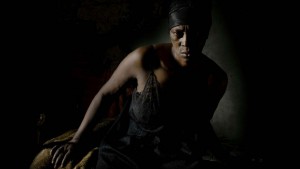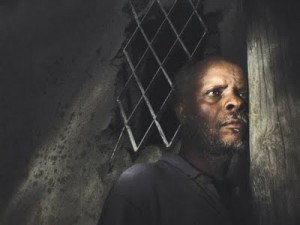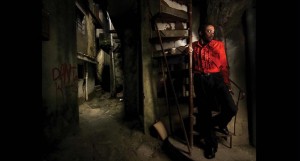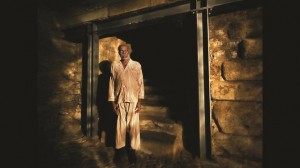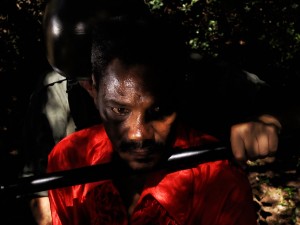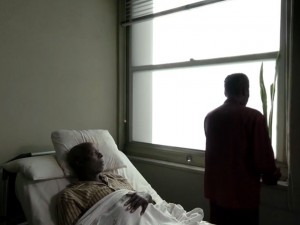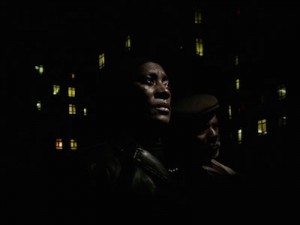An alternate version of my essay on the Costa film, written in May 2020 for Trafic. — J.R.
It isn’t necessary to have seen anything else by Pedro Costa before encountering his title heroine in a film of her own, but if you saw his previous feature, Horse Money, you’ve already met her—a striking, angry middle-aged woman from Cape Verde who finally found the money to fly to Lisbon to join her long-absent husband, only to discover that she just missed his funeral. Settling into his rickety, crumbling house and trying to come to terms with her grief, keeping company mainly with a semi-mad priest (Costa regular Ventura), she’s precisely the kind of person that the world and movies tend to ignore and evade, yet Costa’s epic portraiture, beautifully lit and framed so that it builds an exalted altar to her, invites us to luxuriate in her hushed presence. Audiences tend to have an easier time with this dark reverie than critics because it takes us somewhere very special and respects us far too much to tell us why.
How to explain the appeal of a movie named after a real person, a displaced “non-professional” who is also its star? Or the nature of a film driven by its refusal to separate art from life or fiction from non-fiction–feeling more like a place to visit or a person to hang out with, and less like an event or a story?
Shared by most mainstream critics is the assumption that the fate of Vitalina Varela must somehow be tied to commerce — something we can assume as well about the fate of Vitalina the person. Even though some of us prefer to avoid this as an issue, capitalism isn’t exactly a victimless crime. We even become its casual victims as moviegoers every time we watch a trailer in which we can’t tell who wrote or directed the film because the credits race by too quickly for anyone but lawyers to read them–the assumption being that we’re too crude and stupid to care about such matters ourselves. Respecting us much more even while it ignores many of our desires for narrative clarity and closure, Vitalina Varela places itself in a different category from most of the cinema that we know, even though Costa cites certain older commercial models–John Ford and Anthony Mann, Ernst Lubitsch’s Cluny Brown and Jacques Tourneur’s Curse of the Demon (all of them “movies” as opposed to “films”)—among his treasured touchstones. So as victims we already share something with Vitalina, who’s also defined and manipulated by someone else’s economic concerns. Even her neighbors in Lisbon shun her because her late husband was a crook, despite the fact that they all speak Creole, so that the dialogue of this movie also needs to be subtitled in Portugal and Brazil.
In the two previous extended chapters of Costa’s odyssey about displaced Cape Verdeans in exile, Colossal Youth (2006) and Horse Money (2014), Ventura is the central figure, always playing some version of himself. Here he’s replaced by Vitalina, but he also figures here as someone else–a fragile, deeply troubled and guilt-ridden priest, presiding over a ruined church (created by Costa in the ruins of a suburban movie theater) that Vitalina periodically visits.
Even though we often describe what’s artistic in terms of form or style or genre, what we feel and think are surely just as relevant. And both the emotion and the content of Vitalina Varelacan be described in terms of what’s there and what’s missing — Costa’s contributions (that is, his investments and expenditures) and our own. I suspect that one reason why it provides more difficulties to some film critics than it does to ordinary viewers is a matter of emotional and temperamental investments–what you choose to do with your time in its company.
Inventing its own rules, and therefore reinventing us as spectators in the process, it can’t be easily described in terms of plot because, like Horse Money, it traffics in the sorts of memories that accompany mourning, and these tend to be constant undertows of mood and feeling — perpetual hauntings, so to speak–rather than flashbacks. Moreover, the facts that Costa helped Vitalina get her residency papers and that he chose to make a movie with and about her are two facets of the same impulse, so that we can’t really distinguish between wanting to do something worthwhile and wanting to make something beautiful–thus refusing the neat distinctions commonly made between good works (in the Christian sense) and good work (aesthetically speaking), as if they were somehow meant to be worlds apart.
The intimacy assumed by Costa in order to tell Vitalina’s story — or, more precisely, to help her tell her own story — doesn’t rule out mystery, which pervades everything. We don’t even know what caused her husband’s death, and Costa has admitted in interviews that he was afraid to ask her why she chose to remain in Portugal, adding that she has a son and daughter in Cape Verde — one of the many things that the film chooses to remain silent about.
Beginning and (almost) ending in a graveyard, Vitalina Varelaactually concludes back in Cape Verde on a note of relative hope, still thinking about a future. With a leading lady who does things with the whites of her eyes that I haven’t seen since the silent actresses of Erich von Stroheim and Carl Dreyer, and many different ways of collapsing (or expanding) the past into the present, exteriors into interiors, and a ruined movie theater into a ruined church, everything conspires to create a place that one inhabits rather than a story or a drift—a place that one finally has to help Vitalina to build or repair in order to find one’s own personal space inside it. Like Vitalina, we are what we spend.


